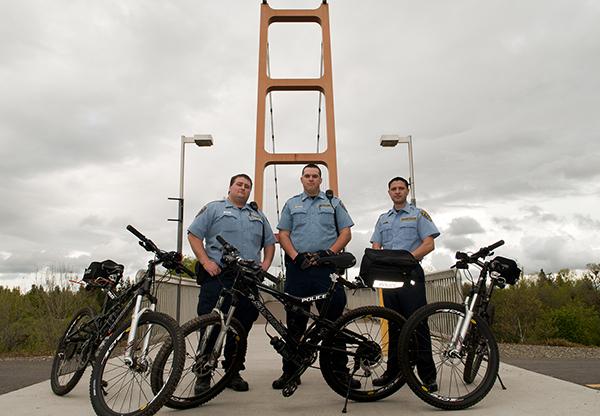Community service officers provide safety on campus

April 24, 2012
Students at Sacramento State strive to keep the campus safe by dedicating extra time as community service officers for University Police.
Sac State has 52 community service officers making the rounds on foot, bike or electric carts to watch out for suspicious activity. The officers consist of student volunteers who take time out of their schedules to serve and protect the Sac State campus, said Cpl. Scott Christian.
“The (community service officers’) primary job is to observe and report,” Christian said. “If they witness a crime, their job is to be a professional observer and notify the police department. We’re trained to go in and deal with escalating situations.”
Sac State Police Chief Mark Iwasa said one-fourth of the officers are students who volunteer for school credit and the rest are paid student interns who incorporate the 24-hour schedule University Police have with their class schedule.
“They’re here late at night, early in the morning – they’re around,” Iwasa said. “Obviously our staff is enhanced at peak load times but they go through a lot of effort to make their shifts and they do a good job.”
There are no experience qualifications needed aside from being a Sac State student and many of them come from various majors, Christian said.
“Generally, we would like to see criminal justice students or students who are interested in law enforcement,” Christian said. “They have to go through an interview process, just like any other job. There’s no experience limit.”
Volunteers who work for school credit through the criminal justice internship course must complete a minimum of 120 hours by the end of the semester. If they want to work more hours, they can, Iwasa said.
“The program allows them to work an amount that works well for them,” Iwasa said. “If they could only do a day a week if that’s a regular shift for them, it’s fine. If they want the hours and meet that commitment, we try to make it work.”
Christian said the number of community service officers working dwindles around 8 p.m.
“It varies from day to day and nighttime to daytime,” Christian said. “We have more (community service officers) on during the day because more students are here on campus and then it drops down at night. It also depends on weekends, summers and any events on campus. It varies.”
Lead community service officer Chris Carter said all officers get an area to patrol and a shift to complete. Some officers are designated to the parking structures as well as the Academic Information and Resource Center and the library.
“We also have (community service officers) in the residence halls,” Carter said. “During the day, we have a roaming (community service officer) that patrol all of campus, inner campus, all the academic halls and everything. We do that on foot and on bicycles.”
The community service officer program was brought to Sac State in 2000 and consisted of four officers patrolling the residence halls. Last semester, University Police fully implemented the CSO program and added approximately 30 more officers. This allows for more security and safety on campus, Iwasa said.
“Since fall 2011, it’s when we fully implemented our structure, including assignments at the parking structures, residence halls and the AIRC, library and the bike compound,” Iwasa said. “Those main assignments in the fall semester have resulted in a significant drop in crime at those areas.”
Carter said being an officer helps his communication skills and allows him to interact with various people at all times.
“You really get to talk to people on a daily basis and it prepares you because we currently have 52 (community service officers) and a majority of them want to go into some kind of law enforcement after college,” Carter said. “So it really prepares you for talking with different people and wearing a uniform and kind of like a command structure working in our department.”
Carter said he helps other officers with their tasks and makes sure everything is where it should be.
“Not only do we provide leadership for other (community service officers), but we also have an increased sense of responsibility within the department,” Carter said.
Iwasa said the program is only partially funded and with budget cuts in the upcoming semester, it is an issue with keeping the CSO program staffed.
“I think we have about somewhere less than a third of the funding required for the program,” Iwasa said. “The rest has been made up through salary savings and other one-time revenue sources. Next year, it could be a problem.”
Despite problems with funding, community service officers work hard to take time out of their day to maintain campus safety, Iwasa said.
“The CSOs are really good at fulfilling their shift obligations,” Iwasa said. “They do a very good job at meeting their responsibilities in the program, no matter what the hours of the shift program are, they somehow manage to do it.”
Camille Anglo can be reached at news@statehornet.com.
































































































































